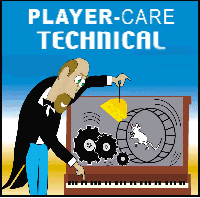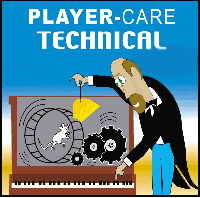
|

|

|

|

|

|
| Home | Manuals | Supplies | Search | Consult | Contact | Testing | Service |


Seeburg Rewind Device Lock-and-Cancel Technology |
|
Although nickelodeons and standard 88-note player pianos operate using the same basic principles of operation, there is one major difference between the two that many people, including technicians, occasionally find somewhat difficult to comprehend. That difference involves what is known as "lock-and-cancel" technology. Most simply explained it means that a perforation on a music roll comes along to 'lock', or turn 'On', a device until another perforation comes along later to 'cancel', or turn 'Off' the device. It's important to note here that in regular 88-note player pianos, a device only remains 'On' as long as the perforation in the music roll is present. With 'lock-and-cancel, the perforation is only present for a short moment of less than a second. So, how does a lock-and-cancel device work? Most simply stated, a device is designed such that when the 'lock' signal is presented, two actions occur simultaneously. The first, and primary action, is to activate the large spring-loaded bellows which shifts the transmission from the Play Mode to the Rewind Mode. The second action, and the one for which such devices are named, is to 'lock' the device into its present mode -in this case, Rewind. This is accomplished by channelling some of the vacuum that powers the large bellows into a small bellows, which collapses and forces open a slightly larger, and potentially more powerful, small bellows (which at this point is held closed by small springs) that opens an orifice which allows atmospheric air into the primary pouch well, keeping the primary valve activated even though the Rewind signal is no longer present. This 'on-and-hold', or locking action occurs within a split second. Since the device is now locked in the Rewind Mode, it will hold the transmission in rewind as long as the large bellows is collapsed. When the roll is almost completely rewound, another perforation, which occupies a different position, or location, on the trackerbar, opens and supplies a signal to the secondary pouch, which in turn causes the secondary valve to activate. That action, which is appropriately called 'cancel', supplies vacuum to the slightly larger small bellows, which easily overcomes the pressure of the small bellows that was holding the slightly larger bellows open, and when the slightly larger bellows collapses, the orifice leading to the primary pouch well is closed. This causes the small bellows and the large bellows to return to their open position. Although it's not immediately obvious in the above explanations, it should be somewhat clear that springs play an equally important role in the operation of a pneumatically operated lock-and-cancel device. Specifically, the spring that is most important is the one which keeps the slightly larger small bellows closed during the Play cycle. It must be powerful enough to keep the orifice leading to the primary pouch well closed but weak enough to be overcome by the pressure applied by the small bellows when the device is triggered into the Rewind mode. There are no written formulas that I'm aware of that can be used to calculate the correct tension of the spring, and even if there were, the springs are simply a piece of piano wire bent in the shape of a Z. |
|
Since "Player-Care" is an internet business, I prefer that we correspond via E-Mail (click here to fill out the 'Request Form'). However, if I'm not in the middle of some other activity, you can reach me at 732-840-8787. But please understand that during the hours from 8AM-5PM EST (Mon-Sat), I'm generally quite busy. So, I probably won't answer the phone. If you get the answering machine, please leave a detailed message stating the reason for your call. Also, repeat your name and phone number clearly and distinctly. By necessity, I prioritize everything in my life. And, if you call and just leave your name and number, and ask me to call you back, it might be a day or two before I return your call. Why? Because I don't know why you want me to call and I might not be prepared to assist you in an effective and efficient manner. If you leave me an E-Mail address (which I prefer), spell it out phonetically. The more you do to help me, the more I can help you in return. Don't rush. You have four minutes to record your message. |
|
407 19th Ave, Brick, NJ, 08724 Phone Number 732-840-8787 (Voicemail Only, No Texts) |
